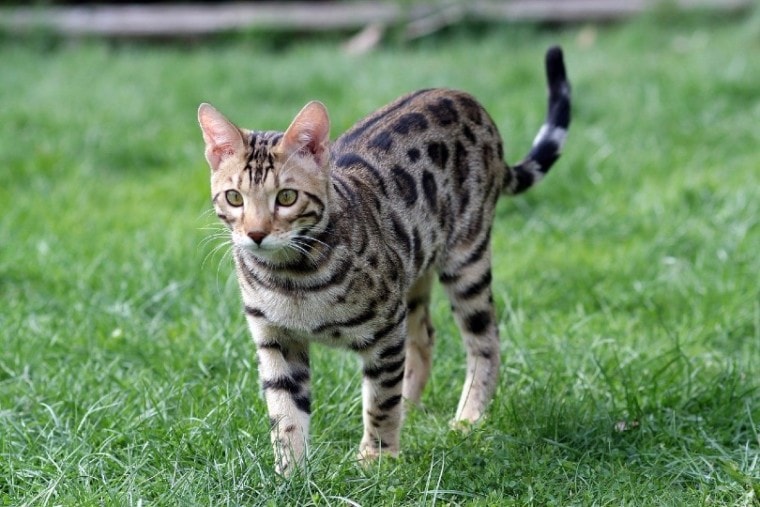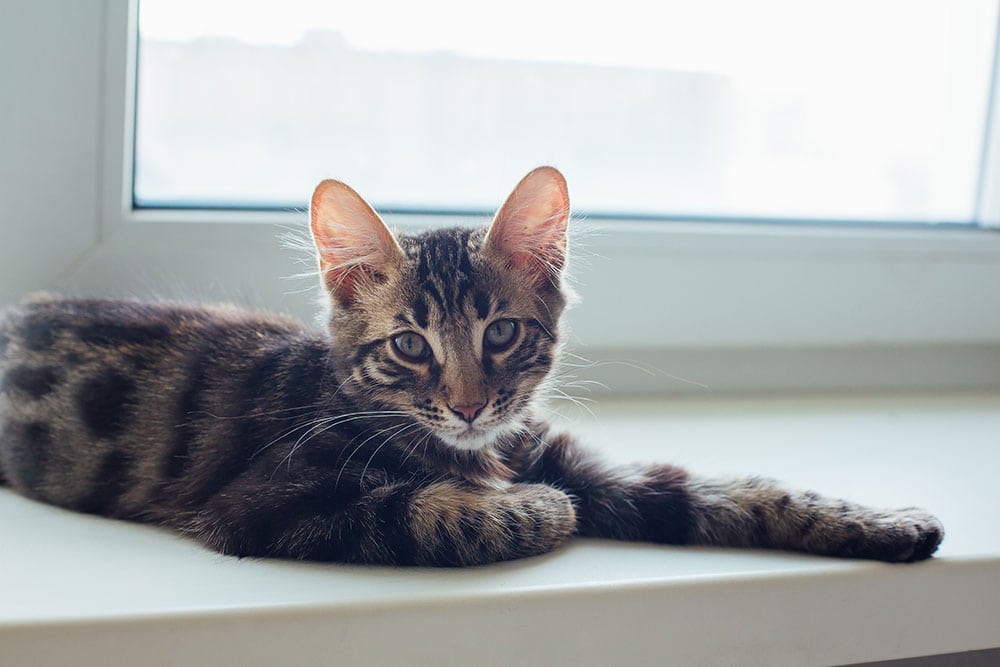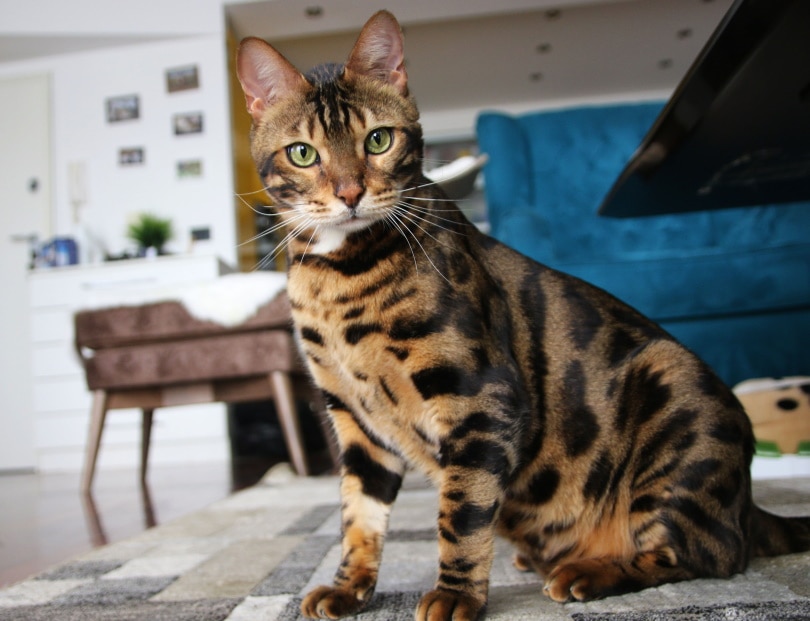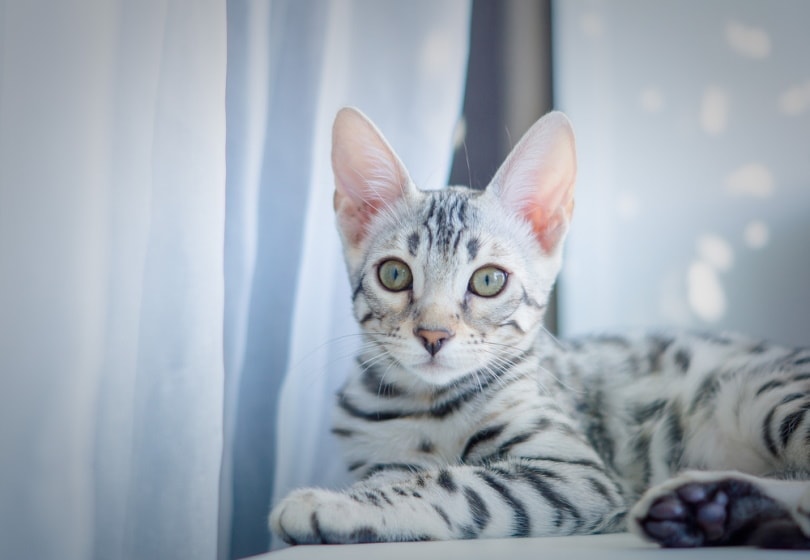
Bengal cats almost resemble the popular “big cats”, which include leopards, lions, tigers, and cheetahs. But these cats are actually hybrid cats that have been around for just a handful of decades. These cats are known for their distinctive beautiful colors, which mimic those of big cats. However, they are smaller and size and only a bit bigger than your typical house cat.
Bengal cats are not only unique, but they are expensive to purchase and can be quite a handful if you have them in your home. They may be livelier and more energetic than your typical house cat and you can expect to pay anywhere from $1,000 to over $3,000 for a new kitten or adult Bengal. So, let’s discuss the most common colors and fur patterns of these amazing cats.
The 8 Typical Bengal Cat Colors Are:
1. Ash/Charcoal

Bengals that have a charcoal or ash-like coat are fairly common and they typically have a long thick dark stripe that will run from their face all the way down their back. Some cats may also appear a dark brownish color, which is more noticeable in natural sunlight. These Bengals often have no patterns or may be covered in rosette, spotted, or sparble patterns.
2. Nut Brown

This is the most common color for Bengal cats is a simple nut-brown shade. This is also one of the most common colors seen out in the wild. The brown cats can come in different shades of brown including caramel, reddish-orange, brownish cream, and honey.
Sometimes the cat will have a darker base coat, which will make the topcoat seem darker than it really is. These cats can often have dark chestnut, black, or dark brown spots or marble patterns. Many people refer to these Bengal cats as, “mini leopards” due to their very similar color patterns and resemblance. They often have yellow or green eyes with solid black tails.
3. Snow White
The snow-white Bengals are probably one of the most expensive cats because of their color. Their base coat is not necessarily wine, but more of a seal or silver hue. These cats come in different varieties including Mink, Sepia, and Lynx, with their main difference being the color of their base coat, something that affects the overall appearance of their topcoat.
For example, the sepia cats are the darkest in this variety. Their base coat is typically a light brown hue and typically has various marbled or spot patterns. The seal Bengals have more of a creamy or light brown hue, due to their light-colored base coat.
They may also have marbled or spotted patterns and usually appear light whitish brown in color. The lynx Bengal very few to know patterns or markings on their body. Their coats are almost all white. But their feet and heads are typically charcoal, dark grayish color. They also have striking steel-blue eyes and long black tails.
4. Silver-White

Another common Bengal color is a silver-whitish hue. These cats almost look completely gray, but they may have marbled or spotted patterns of black, white, or off-white. Typically, the cat will have charcoal or bluish shades on its body, but not necessarily on its feet or its face–these areas will normally be either lighter or darker. However, these cats normally have green eyes and all-black tails.
5. Marble

Most Bengals will have some form of spots, stripes, or swirled pattern on their topcoat. This is what makes these cats unique. The patterns can come in different shapes, sizes, and colors,
And the type of pattern that a cat has will depend on how it is bred.
6. Black
Black Bengals almost resemble black panthers. They typically have emerald green or yellow dyes and may have marbled or spotted patterns on their top coat. However, they’re mostly black, and people often refer to their patterns as “ghost marks” due to their high visibility in natural sunlight.
7. Sparbled
The “sparbled” Bengals are an interesting variety. These uniquely colored cats are beautiful and come in a wide variety of colors. It’s their pattern that makes them stand out from other Bengals. Their coats come in different shades including charcoal, brown, ash-gray, and black. They have rosette-shaped spots in addition to swirls, making them resemble cobra snakes–something that makes them easily identifiable.
8. Steel-Blue
These Bengals come in different color varieties as well. While many of the cats will appear a powdery blue or light blue to my son may be wide with hints of gray or charcoal in their pattern. Overall, these cats tend to have a cream-like coat and most have a darker gray color with spotted or marble patterns. They typically have green or hazel eyes, with long dark tails.
What Are the Most Common Patterns For Bengal Cats?
Patterns are what make a Bengal cat stand out from a typical house cat. Other than the fact that these cats are a bit larger, it’s their spots and the pattern of these spots that set them apart from wildcats. Here are some of the most common patterns on Bengal cats.
Single Spots
Single spot is probably one of the most common patterns on Bengal cats. These spots can appear in various colors including black, brown, or dark gray– and it’s usually in contrast to the cat’s main color. The spots will usually resemble that of leopards and will typically be all over the cat’s body, except its face, feet, and tail.
Rosette Clusters
Most Bengals will have some form of a rosette-shaped pattern all over their back. Typically, these shapes will appear in colors all over the back and sides of the cat and it’s normally in contrast to the cat’s base coat. For example, if the base coat is nut brown, the clusters will usually be dark brown, black, or ash.
The closeness of the clusters can also vary with some patterns being very close together and others having wide spacing, some may also have an arrowhead or triangular shape. Also, some rosettes may have a donut-shaped appearance, or what’s known as “pancakes”. These clusters have a 2-layered ring of contrasting colors, giving the Bengal cats a leopard-like appearance.
FAQs: Bengal Cat Colors
How Do Bengal Cats Get Their Colors and Patterns?
Bengals get their patterns and colors from the dominant and recessive genes of both the domestic cats and leopards from which they originate. However, many genes can influence the pattern and color of each cat.
Which Bengal Colors Are the Rarest?
As mentioned previously, the most common colors that you’ll find in Bengal cats are nut brown, and silver-ash. Consequently, these cats are also the least expensive Bengal cats that you can purchase. Rare breeds include cats that are snow colored. These cats are bred from leopards and Siamese cats and or are less commonly seen–especially here in the States. These cats can cost upwards of $5,000 each.
When Did Bengal Cats Originate?
Bengals originated in Asia around 1970 when Jean Mill, a local breeder and author of the book “The Guide to Owning a Bengal Cat”, began breeding experiments with wild cats and domestic cats. After many failed experiments, Loma Linda University began to conduct its experiments in the nineteenth century and is often credited with many breed variations.

Do Bengal Cats Have to Be Groomed?
Yes. When it comes to grooming your Bengal cat, brushing is definitely a part of the requirement. The great thing about Bengal cats is that they typically shed very little, and much less than most other cat breeds. It’s for this reason that many people believe they are hypoallergenic, though they technically aren’t, they just tend to cause fewer allergy issues in humans.
A regular de-shedding or slicker brush will work for grooming Bengal cats. The number of times that you will need to groom your Bengal cat will vary, depending on the cat, but you may find that you only need to brush the cat once a week–if that.
How Often to Wash Bengal Cats?
Similar to brushing, you also mean I need to wash my Bengal cat as often as a typical house cat. Washing these cats too much may cause their skin to become dry, which can cause excessive shedding. The National Cat Groomers Association has stated that pet owners should only wash these cats about every 4 to 6 weeks and no more than this to prevent skin issues.
Wrapping Things Up
Bengal cats are beautiful unique creatures that can make for great house cats. They come in a variety of colors and with different color patterns, making each specific cat unique. Bengals are energetic cats that normally require less grooming than traditional house cats, something that older or less mobile cat owners may appreciate. However, if you plan to own a Bengal cat, be sure to save your pennies, as these cats typically cost anywhere from $1,000 to $5,000 each.
Featured Image Credit: Irina_kukuts, Pixabay







